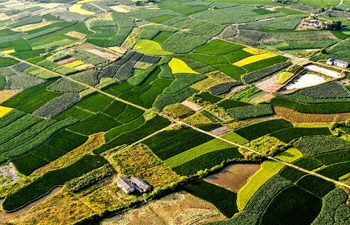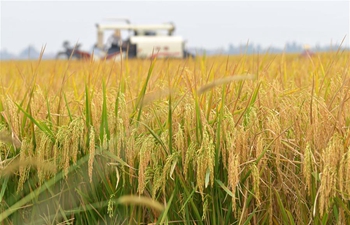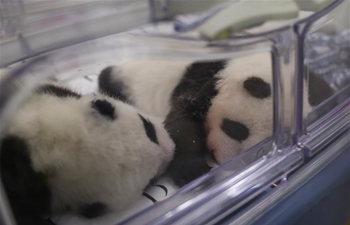SYDNEY, Oct. 4 (Xinhua) -- Australian palaeontologists on Friday announced the discovery of an entirely new species of pterosaur which they say lived roughly 96-million-years ago and had a wingspan of over four meters -- earning it the name "iron dragon."
The fossilized bones were a chance discovery by local farmer, Bob Elliott who was working on his sheep station in the northeastern margins of the Winton Formation, in the state of Queensland back in 2017.
Staff and volunteers from the Australian Age of Dinosaurs Museum (AAOD) were called in to excavate the site, further uncovering the ancient remains.
What they found constitutes the most-complete example of a pterosaur ever discovered in Australia, consisting of a large portion of the jaw, skull and crest, five partial vertebrae, eight limb bones, as well as 40 partial and isolated teeth.
They named the new species, ferrodraco lentoni, meaning Lenton's iron dragon, in recognition of former Winton mayor, Graham Lenton.
The project was led by AAOD palaeontologist Adele Pentland as part of her PhD in vertebrate palaeontology through Swinburne University of Technology.
Pentland told Xinhua that pterosaurs are piscivorous and the creature would likely have fed on fish in the lake and river systems in the Winton area.
"With a wingspan of around four meters, Ferrodraco would have been an apex aerial predator around 96 million years ago," Pentland said.
"At this time, the Winton region was on the southern shores of an inland sea and was globally positioned about where the (Australian State of) Victoria's southern coastline is today," Pentland said.
Pentland explained that pterosaurs aren't in fact dinosaurs, but reptiles and evolved on a separate branch of the evolutionary tree.
Pterosaurs were in fact a very successful species and have been shown to have flourished throughout the entire dinosaur age, a period of roughly 150 million years.
However, their fossils are exceptionally rare, particularly in Australia, due to their bone structure which is largely hollow.
AAOD Co-founder David Elliott described the find as one of the museum's most exciting accessions.
"The Winton area has produced the majority of Australia's large dinosaur fossils so presenting a significant pterosaur skeleton alongside the giants with which it co-existed is a huge bonus for science, education and regional tourism," Elliot said.

















